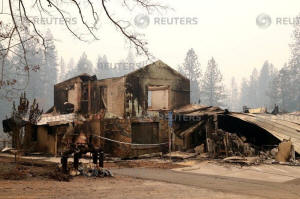|
Evacuation plan 'out the window' when
fire hit California town
 Send a link to a friend
Send a link to a friend
 [November 19, 2018]
By Andrew Hay [November 19, 2018]
By Andrew Hay
(Reuters) - When a "megafire" engulfed
Paradise, California, officials and residents had to abandon their
evacuation plans and improvise new ways to save lives, learning lessons
that could help the growing number of U.S. communities at risk to
wildfires.
As strong winds sent flames roaring into Paradise at 2 miles per minute,
emergency personnel and locals realized their escape plans, crafted
after a 2008 blaze, would not work.
"The lessons we had learned in the past kind of went out of the window
due to the sheer speed and intensity of this fire," Paradise Emergency
Operations Coordinator Jim Broshears said in a phone interview.
The small mountain town was facing the so-called Camp Fire, one of a
series of recent "megafires" fueled by drought, erratic winds and
overgrown forests that quickly torch over 100,000 acres.
A week after California's deadliest blaze, which killed at least 71
people, residents were critical of the town's alert system. Broshears
said other towns could save lives if they taught residents to shelter
from fire and got more of them to sign up for alerts.

"GO ALL OUT"
As Paradise was engulfed around 8 a.m. on Nov. 8, officials attempted a
staggered evacuation using their CodeRED alert system to target a zone
at a time. They wanted to avoid the panic and chaos that ensued in 2008
as all 27,000 residents tried to flee at once.
With the fire toppling power lines and mobile towers, and residents
jamming networks with calls, about 60 percent of CodeRED alerts were
delivered, according to Troy Harper a spokesman for OnSolve, the company
that provides the service.
Between 25 and 50 percent of residents had signed up for the optional
system, Broshears said, meaning 30 percent of households, at best, got
alerts.
As the town burned, officials abandoned the phased evacuation and told
everyone to get out, Broshears said.
"We felt we morally couldn't do that and just had to go all out and hope
for the best," said the former Paradise fire chief, who has lived in the
town since 1974.
Locals like nurse Darrel Wilken said an old-fashioned siren system would
have been better than CodeRED.
"People who are not connected to the internet or phone need to know
there is a fire," said Wilken.
'PLAN DIDN'T WORK'
Paradise widened, paved and straightened roads after the 2008 blaze to
allow for a speedier evacuation. But the Camp Fire burned across all
escape routes.
"The flow plan didn't work," said Broshears. "We couldn't flow huge
amounts of traffic down an available highway because there was no
available highway."
[to top of second column]
|

A building destroyed by the Camp Fire is seen in Paradise,
California, U.S., November 13, 2018. REUTERS/Terray Sylvester

The fire moved faster than anyone expected, throwing embers that
reached 2 miles (3 km) ahead of the flames, Paradise Mayor Jody
Jones said.
"I don't know that there's a city or town in the entire world that
could evacuate their entire population all at the same time and not
overwhelm their roadway structure," Jones told CNN in an interview
on Saturday.
On the ground, residents fought to escape the town.
Wilken, 51, got word around 8 a.m. that the fire was 7 miles away.
By 8:15 a.m. trees outside his window at the Feather River Hospital
were on fire.
There was no time to gather ambulances to evacuate the 67 admitted
patients as staff had trained to do.
"If your car was not on fire, you were the ambulance," said Wilken,
who loaded three patients into his Subaru WRX.
His designated escape route was blocked by flames. He wove through
back streets and a slalom of burning vehicles, his car exterior
melting from the heat, trees and electricity poles falling on
vehicles ahead, before reaching safety hours later.
As Wilken fled, firefighters and volunteers including resident Mike
Boggs tried to get into town. Police had turned all exit routes into
contraflows, a move that sped up the evacuation, but obstructed
first responders trying to enter Paradise. Boggs went off road and
drove up a ditch in his pickup, followed by a fire truck.
The 60-year-old iron worker credits a decision after the 2008 blaze
with saving his and nearby homes in Butte Valley, near Paradise. He
bought 40 cattle that grazed on grass that would have otherwise fed
the fire.

"Everywhere I put my cows it didn't burn," said Boggs.
For Broshears, one of the biggest lesson from the Camp Fire was that
residents facing a megafire might sometimes be better off sheltering
in open spaces, like road intersections, than trying to outrun
flames.
"It would be ugly but you'd survive," he said.
(Reporting by Andrew Hay, additional reporting by Noel Randewich;
Editing by Daniel Wallis and Cynthia Osterman)
[© 2018 Thomson Reuters. All rights
reserved.]
Copyright 2018 Reuters. All rights reserved. This material may not be published,
broadcast, rewritten or redistributed.
Thompson Reuters is solely responsible for this content. |